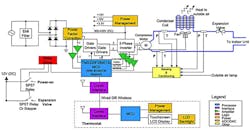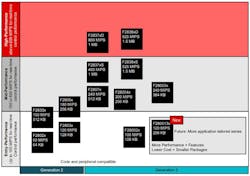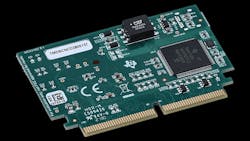Members can download this article in PDF format.
Increasingly, businesses and individuals are looking to cut their electric bills and reduce their carbon footprints. A good place to start is to identify how electric energy is being used. Texas Instruments cites an estimate that electric motors and power supplies account for more than half of electric-energy use in industrial, commercial, and residential settings worldwide, and that only about 10% of such power comes from renewable sources.
Sponsored Resources:
- How Intelligent Control Can Improve Energy Consumption
- Product Overview for C2000 F280013x Real-Time Microcontrollers
- LaunchPad Evaluation Module
To reduce energy consumption from both renewable and nonrenewable sources, you can add intelligent variable-frequency digital control loops to your motor-drive and power-supply designs. The use of such control loops can cut energy use up to 25% or more, promising significant energy-efficiency improvements in many applications areas.
An air conditioner is one potential application for digital control. The compressor and fan motors might require control loops operating at 20 kHz. An air conditioner also requires a power-factor-correction (PFC) stage, which may necessitate a control loop operating at frequencies to 50 kHz. To reliably implement all of these loops, you would need a microcontroller unit (MCU) that can execute the appropriate algorithms efficiently in real-time with very low latency.
Solar energy is another application that can benefit from real-time MCUs. The solar market is moving from centralized high-power systems to distributed low-power systems that incorporate several solar panels, each connected to a micro-inverter or power optimizer.
Each micro-inverter or power optimizer in turn requires a real-time MCU that can execute the maximum power-point tracking (MPPT) algorithm necessary to extract the maximum amount of energy from the solar panels under varying conditions of illumination. To keep the many deployed inverters and optimizers affordable, the MCUs must be low cost.
Real-Time MCU
TI addresses the need for low-cost real-time control with its TMS320F280013x Series MCU, which targets air-conditioning, distributed-solar, and other applications requiring compact, economical motor drives and power supplies. Figure 1 shows the TMS320F280013x in a typical air conditioner. The company’s TIDM-02010 reference design provides more information.
A member of TI’s C2000 MCU family, the TMS320F280013x incorporates a 120-MHz, 32-bit central processing unit (CPU) enhanced for digital signal processing (DSP). The TMS320F280013x’s optimized C2000 real-time MCU architecture—which reduces latency between sensing, processing, and control—enables the device to offer real-time signal-chain performance equivalent to that of a 240-MHz alternative device.
The TMS320F280013x includes a floating-point unit (FPU) to perform precise mathematical calculations and a trigonometric math unit (TMU) to speed up real-time control algorithms. It incorporates up to 256 kB of flash memory as well as up to 36 kB of RAM.
The MCU also includes 38 individually programmable general-purpose I/O (GPIO) lines, two 12-bit 4-Msample/s analog-to-digital converters (ADCs) supporting up to 21 external channels (including 11 channels shared with GPIO), and four windowed comparators with reference DACs. For actuation, the device provides 14 pulse-width-modulation (PWM) channels, including two offering high resolution (150 ps) to enable improved accuracy and reliability.
For communications, the device offers a CAN interface, three UART-compatible Serial Communications Interface (SCI) channels, one Serial Peripheral Interface (SPI) port, and two Inter-Integrated Circuit (I2C) interfaces.
To ensure security, the device features a dual-code security module, which prevents access to on-chip secure memory, and a unique ID stored in a device-identification register. It also offers secure-boot and JTAG-lock functions and supports Cipher-based Message Authentication Code (CMAC) and the Advanced Encryption Standard (AES).
In addition, missing-clock-detection logic protects against spurious CPU writes to memory, and a dual-clock comparator can monitor the clock input to detect clock faults. These capabilities enhance system safety metrics to help ensure compliance with standards such as the International Electrotechnical Commission’s IEC 60730, which addresses automatic electrical controls for household appliances.
With its 120-MIPS specification and low cost, the TMS320F280013x is a cost-optimized Entry-Performance member of TI’s Generation 3 C2000 real-time MCU family. TI also offers Mid-Performance and High-Performance C2000 MCUs, with specifications summarized in Figure 2.
All Generation 3 devices are compatible with TI’s C2000WARE software, which consists of a cohesive set of development tools that include device-specific drivers; math, DSP, and control libraries; utilities; hardware design schematics; and documentation. In addition, the TMS320F280013x is compatible with SysConfig, a GUI-based intuitive, comprehensive collection of graphical utilities for configuring pins, peripherals, radios, subsystems, and other components.
SysConfig offers full peripheral configuration, integrated tool support, dependency detection across modules, one-click setup of C2000 libraries, memory-configuration support, and board-component support to simplify migration and speed development.
Evaluation Module
To help you get started on designs based on the TMS320F280013x, TI offers the TMS320F2800137 controlCARD evaluation module (Fig. 3) for initial prototyping. The card, which works with the TI TMDSHSECDOCK docking station, includes an HSEC180 180-pin high-speed edge connector that makes available analog I/O, digital I/O, and JTAG signals.
The module’s isolated on-board XDS110 USB-to-JTAG debug probe enables real-time in-system programming and debugging, and hardware files are available for C2000Ware software. A USB-C cable connects the card to your computer and delivers 5 V at 500 mA to the card. You can use an external power supply if your design’s power requirements exceed the USB power limits.
With the controlCARD, you can experiment with a variety of real-time control issues, ranging from UART connectivity to clocking methodology. Of particular importance are the TMS320F280013x’s ADCs.
By default, the controlCARD comes with 0-W shunts in place of inline resistors at the ADC inputs, and it omits capacitors to the ground plane. The appropriate resistor and capacitor values can be chosen based on the characteristics of your input signals and requirements for settling time and other parameters such as signal-to-noise ratio (SNR), total harmonic distortion (THD), and signal-to-noise and distortion ratio (SINAD).
Conclusion
Low-cost MCUs like the TI TMS320F280013x provide an affordable way to add efficiency-boosting digital control to applications extending from household appliances to grid-connected distributed solar-power systems. To help ensure your success, TI provides a variety of resources, including reference designs and evaluation modules as well as the C2000 Academy, which offers interactive classes, advanced workshops, and videos.
Sponsored Resources:



